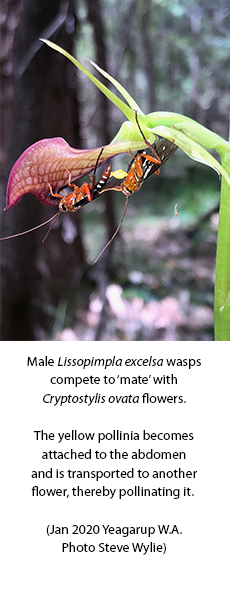<< BACK TO PROJECT LIST
Project: 340/2021
Title: Genetic diversity, mycorrhizal associations and the virome of Cryptostylis ovata, the Western Australian slipper orchid.
Applicant: Dr Steve Wylie
Institution: Murdoch University, 90 South Street, Murdoch WA 6150
Cryptostylis is a poorly-studied genus of orchids consisting of about 25 species. The genus appears to be centered in Papua New Guinea, the region where about half the species live. Other species live as far apart as Sri Lanka, Taiwan and New Zealand, and several countries in between. Australia has five indigenous species—four in eastern Australian states and one in Western Australia (WA). Our focus will be the one in the west, namely Cryptostylis ovata.
C. ovata is a mainly terrestrial orchid. Occasionally it becomes epiphytic (on live trees) and geophytic (on rocks). It is unusual among the 400+ species of indigenous terrestrial orchids from WA in that it is evergreen—it retains green leaves all year round, whereas all the other orchids are deciduous, living for some or most of the year unseen, underground. The leaves of C. ovata superficially resemble juvenile leaves of some Eucalyptus species, which they appear to mimic C. ovata flowers in the hottest and driest time of the year, and plants can have from one to about 20 flower spikes, each with a number of upside-down flowers. The flowers mimic the flightless female wasps of the species Lissopimpla excelsa, and male L. excelsa wasps enthusiastically ‘mate’ with C. ovata flowers, thereby pollinating them.
C. ovata, and other species in the genus, appears to have a very low seed germination success rate. The plants appear to be long-lived, certainly for many decades and possibly far longer. We know this because plant colonies expand slowly by underground rhizomes, yet clonal plants have been found growing many metres apart, suggestive of hundreds of years of growth.
We will study four aspects of C. ovata biology:
1. The genetic diversity of the species across its natural range.
2. The physical (morphological) diversity of the species in terms of its size, shape, colour, flowering times, flower numbers etc.
3. The range of fungal partners it forms symbiotic partnerships with.
4. The range of viruses that live with C. ovata populations.



Research Outcomes
Genetic diversity of populations: This study investigated the genetic diversity and population structure of Cryptostylis ovata orchids in Western Australia using 5,466 SNP markers derived from DArTseq analysis. Most genetic variation (73.5%) occurred within populations, with moderate differentiation between them (FST = 0.265). Principal Coordinates Analysis revealed clustering largely aligned with geography, though exceptions suggested additional influencing factors. Isolation by distance was negligible, indicating limited gene flow, likely due to restricted pollinator movement and habitat fragmentation. Observed heterozygosity exceeded expected values, and Shannon’s diversity indices indicated moderate within-population diversity, with notable outliers like the genetically distinct Bowelling-Duranillin Road population. Despite habitat modifications, populations retained ancestral genetic signatures, underscoring the importance of conserving genetic diversity. The findings highlight the need for broader genomic studies to understand adaptive traits and inform conservation strategies for this and other orchid species facing habitat loss.
Virus status of populations: This study reports the first detection of viruses infecting Cryptostylis ovata, identifying bean yellow mosaic virus (BYMV) and Ornithogalum mosaic virus (OrMV) in two populations. All eight plants collected from the Bowelling-Duranillin Road population exhibited virus-like symptoms and were co-infected with identical isolates of BYMV (BYMV-BDW) and OrMV (OrMV-BDW), suggesting a single clonal plant with systemic infection. Phylogenetic analysis revealed that BYMV-BDW shares high similarity with isolates from Asia and North America, while BYMV-Devlin (from another population) closely matched local Western Australian strains. OrMV-BDW showed 98–99% identity with isolates from wild Australian orchids and an African Lachenalia sp., indicating a likely introduction via ornamental plants. Despite the presence of aphid vectors, exotic virus prevalence was low (2/16 populations tested), and no indigenous viruses were detected, as have been described from other genera of Australian orchids. The spillover of these exotic viruses, potentially from invasive weeds, escaped bulbous garden plants of southern African origin, or legume crops, raises concerns for orchid health, warranting further study on their ecological impact and transmission pathways.
References:
Shu Hui Koha*, Hua Lib, Steve Wylie., 2025. Investigation of genetic diversity and population structure of wild Cryptostylis ovata orchid populations in Western Australia using SNP markers. Under Review
Wylie, S., Li, H. and Koh, S.H., 2025. A survey of wild indigenous Cryptostylis ovata orchid populations in Western Australia reveals spillover of exotic viruses. Viruses, 17(1), p.108. doi: 10.3390/v17010108


